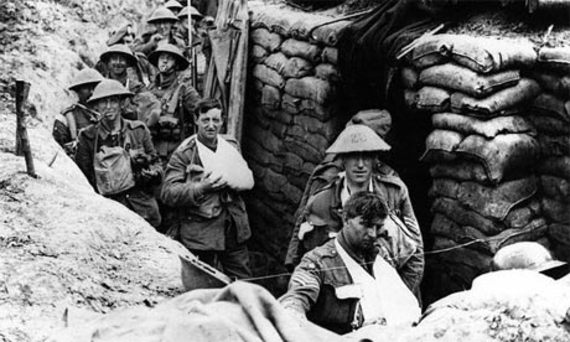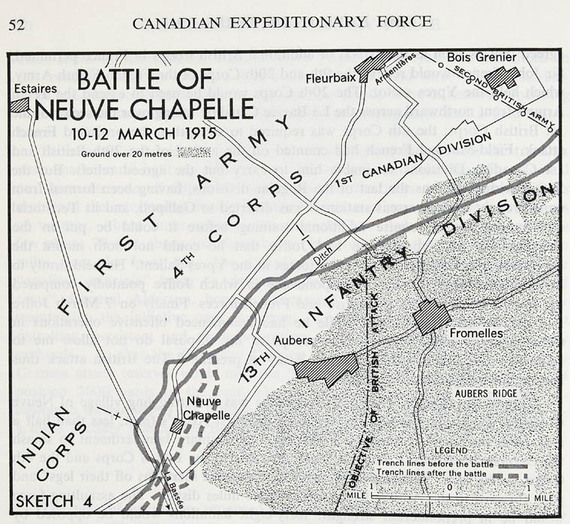British Troops on the Western Front, Flanders, Winter 1915
The Western Front: Winter 1915
The military strategy in the 1914 campaign had been straightforward. German forces had intended to sweep from the northwest into northern France in an attempt to break through the French lines and encircle the French army in a broad enveloping movement. Once surrounded, the hammer of the German right flank would fall against the anvil of the German center and left flank. Caught in the middle, the French forces would be annihilated and France would be forced out of the war. This was the strategic essence of the Schlieffen Plan. The Allied response was to slow down and blunt the German attack and prevent the encirclement and destruction of the French Army. The German plan failed. In that sense the Germans were defeated, although not yet vanquished. For the Allies, however, the German defeat was not the same as an Allied victory. German forces still controlled the industrial heartland of France and the Allies seemed incapable of rolling back the German tide.
The Western Front 1915-1916
For the next three years each side would look for a decisive breakthrough that would allow it to outflank its opponent and roll up its forces. Relying for the most part on massed infantry attacks across a no-man's land of barbed wire obstacles and mine fields preceded by a preparatory attack of sustained artillery bombardment, both sides continued to pour men into a meat grinder with seeming indifference to the mounting human losses. In the first years of the war, existing technology tilted the battlefield sharply in favor of defending forces. Human courage and determination was simply no match for rapid-fire machine guns and massed artillery.
In time, both sides brought in their technological prowess to develop weapons that would change the odds in favor of the attacker: tanks, flame throwers, more effective forms of poison gas, all helped to reduce the overwhelming advantage held by the defenders. Even then, the war on the Western Front would remain largely static, its boundaries limited, at best, to a few miles on either side of the line of trenches. In most cases, progress was measured in yards. The only thing that changed was the mounting toll of dead and wounded.
The Battle of Neuve-Chapelle
By the spring of 1915 on the Allied side of the line, Belgian forces controlled a 21-mile front along the Yser River and the Yperlee canal, from Nieuwpoort to Boesinghe. The British Expeditionary Force guarded a line stretching to south of St. Eloi in the valley of the River Somme. The rest of the line, all the way to the border with Switzerland, was the domain of the French army.
Once the battle lines of the Western Front had been drawn, the two sides searched for ways to break them. As Marshal Joffre's planners poured over the maps, one obvious possibility jumped out at them: a bulge in the line of trenches near the town of Compiègne, on the river Oise. According to Joffre's plan, British and French forces would attack from both sides and cut off the bulge, or salient.
2nd Gurka Rifles at the Battle of Neuve Chapelle
Accordingly, the morning of March 10, 1915 saw an assault by four British Empire divisions (including a large contingent from India) along a 2-mile front at the village of Neuve-Chapelle in the Artois region. The attack followed a 35-minute artillery bombardment and was supported with aerial attacks by Britain's Royal Flying Corps (RFC). The thrust was initially successful, with the German defenses overrun and the village secured, but the advance was held up by a determined German rearguard and poor communications. Two days later came a counterattack from forces commanded by Crown Prince Rupprecht and the campaign was called off on March 13. In recapturing about one mile of ground, the 40,000 Allied troops who took part in the Battle of Neuve-Chapelle had suffered 11,200 casualties - 7,000 British and 4,200 Indian. The Germans had suffered much the same fate.
German Prisoners of War, Battle of Neuve Chapelle
The Battle of Neuve-Chapelle would prove to be the first of a long series of inconclusive battles on the western front. Determined to achieve a breakthrough, the Germans would unleash a devastating new weapon at the next major battle to follow, poison gas. That battle would be remembered as the Second Battle of Ypres.





